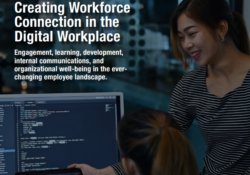Part 2 (Part 1 is contained in our Q1 2020 issue)
We recently reached out to a few long time members of the IHRIM association (including one of the Founders, Sid Simon) to get their impressions of the many changes in HR, HR Technology, and our association. Since there was so much ground to cover and each person had much to contribute, we thought we would format this like a panel discussion. Enjoy the questions, the responses and the trip through history and please provide us your thoughts on what has changed on all fronts.
Our contributors are:
- Sid Simon (SS)
- Marc Miller (MM)
- Freddye Silverman (FS)
- Jim Pettit (JP)
- Nov Omana (NO
1. Would you say the HR Technology vendors have changed in terms of:
-
-
- Sales approach
- Implementation
- Customer support
- Contracting
- Product development
-
- I’m not giving away any trade secrets when saying as a vendor my objective was to sell the product I represented – doubt that objective has changed. The vendors have enhanced sales approaches, implementation practices, and customer support as the software tools have enabled them to perform better. Development is constant as is demanded in the marketplace and for differentiation. I’m not sure if my old theory about conducting a vendor comparison is still more art than science, but wouldn’t be surprised if with either outcome is prevailing these days. (SS)
- a) I have seen the top tier HRMS providers make a strong effort to educate their sales staff and sales support staff in the need to sell the concept of their building a business partnership with their clients, one based on achieving value to the entity.b) My experience and perception remain that the overall time to “go – live” has been made shorter as a result of effective use of preset delivered templates and workflow – delivered in the SaaS environment. Trust the HRMS provider. They have proven trustworthy and will strive to deliver a well thought-out functional solution because they have built their product based on strong knowledge of legislation, best practices and the experience of their clients who have come before you.c) My perception and experience shows that more and more of the customer support to a client is offered in a virtual environment. Video training, data input and needed feeds to other systems seem to be able to be accomplished without any (or a lot) of face to face meetings and hand holding. Input forms, set up (or validation tables) needed for payroll and benefits administration and workflow rules are provided as “drop down” choices for most decisions made by subject matter experts.d) I have seen more vendors bundle their core offerings for an integrated HR, Payroll and Benefits Administration – and the PEPM has been coming down to lower levels. However, many vendors are now offering premium functionality – as “beyond core” modules at additional PEPM rates. It often turns out that the needed functionality of most progressive organizations reside in the latter category, especially dealing with aspects of Talent and Workforce Planning and succession planning – thus bringing the overall pricing of PEPM to a higher rate than in previous iterations of their offerings. (MM)
- I think they’ve changed in every way. Market entry is much easier now due to technology and ability to get exposure so competition, especially among niche vendors, is still very real. Sometimes they are competing to see who will be bought for how much by the big guns, but that’s old news. Also, as I stated above, due to the Cloud, the ability to change providers, while still not simple, is much more conceivable now (since clients don’t have heavy investments in extensive internal staff or hardware supporting the HR systems), which puts more pressure on vendors to stay top-notch in development, pricing, contracting and customer support. Speed continues to be a heavy hammer – speed to market, quicker negotiations, rapid implementations, and upgrades coming out more frequently with expanded capabilities. Companies no longer think in terms of long-term planning. They focus on months, not years because the business world changes very quickly these days. (FS)
- a) More direct marketing to HR consumers, bypassing the IT purchasing processes.
b) Leveraging pre-configured “best of breed” processes to shorten the implementation cycle. (JP) - a) Successful sales are more than addressing “pain points”, they are now more consultative to the business and HR not only solving current problems/needs, but future directions.
b) Vendors come to the table with templates and processes that somewhat automate the implementation better, but the client’s translation of what they want/need to what the vendor offers is still as complex as ever, especially since “customization” as we have known it has been replaced with the vendor’s “best practices” configurations.
c) The technology around customer support has increased to be less personal and more automated (FAQ, chatbots, videos, etc.), which I believe is LESS appealing than the former models of support.
d) The cloud has introduced new models of “buying” software (subscriptions), length of contract (now 2-3 years as opposed to perpetual), ownership of data and privacy, security and remediation, “uptime” and penalties.
e) With more attention on the client community (and establishing virtual communities of connection), product development is aided by more direct client interaction, allowing the see trends in needs, observe how clients solve more basic needs amongst themselves, and can help to introduce ideas for new capabilities directly into the client community based on specific parameters (company size, industry, roles, etc.). I see this as commoditizing the product development, allowing them to be more focused on true innovation rather than being just market driven. (NO)
2. As IHRIM moves into a new decade, what role do you anticipate IHRIM will have in the industry?
- I think this is the toughest question. One I’ve asked myself a few times! I think IHRIM will always have a place as an education provider and warehouser, certification owner and industry representative in terms of the HRIT/HRIS people, not vendors. I hate to see the networking ability fade into the electronic miasma that currently exists and honestly hope there’s a backlash when people realize that younger generations entering the workforce have literally no idea how to make eye contact, hold a conversation or interact in person at all. No exaggeration there – my sister is the director at a major state dental graduate school who has bemoaned the fact that despite behavioral interviewing they’ve found that the students who they’ve accepted, while academically excellent, are flaming out as soon as they start their clinical work since they cannot relate to patients and don’t know how to speak to them. Very sad – and that same red flag applies to all professions. In the years I was active in IHRIM, the meetings and conferences were invaluable to me, not only for what I learned in the sessions but also for the unlimited opportunities to meet other people in the field, exchange ideas, get referrals, even find exceptional hires for my staff. I hope there is a return to that in some way – there certainly is a need for it. (FS)
- IHRIM fulfilled a need in the early days by providing a marketplace for HR technology owners, administrators and technicians to investigate and shop for new technology, implementation services while developing their network with vendors, consultants and practitioners in the HR systems industry. The shopping mall per se of HR technology. For HR and IT professionals, usually initially inspired to investigate IHRIM due to a local project need some stayed connected as others passed through when they returned to other HR or IT responsibilities. As the use of technology has expanded within the HR filed and the Amazon inspired buying experience changing the evaluation and purchase process IHRIM’s role is evolving from being the HRIT marketplace to the University of HR Technology higher learning. With an expanded target “student” population of anyone in the HR industry, a growing curriculum to the 80’s core of system evaluation, selection, implementation/deployment project management to include data governance, analytics, emerging technologies IHRIM focus on education and certification is filling an industry void. Utilizing vendor, consulting and industry thought leaders as the faculty IHRIM will provide a pipeline of certified, qualified HR technologists for organizations and their consulting partners. (JP)
- I see IHRIM continuing to be the hub of HR Technology content, providing insights, instruction, connection, and support to a growing audience of HR Technology interested parties. Our core of HRIT individuals continues to grow as we see the boundaries of HR tech grow and encompass more of our lives. This is starting to include many we would have not thought to be our audience, but could be consumers of what we provide as services in some way. I would say, START with IHRIM when dealing with anything HR Tech – you will find the answer or be guided where the answer lies. (NO)
3. What was the primary reason for the formation of such an organization and is that still a current need? Both Sid and Marc combined questions for an interesting set of observations.
- This could end up becoming a book – however, don’t fear, will try to keep it short and sweet. My opinion has always been that a professional association exists if it is filling a need of its members – it can be a real or perceived need, but regardless a need is being satisfied. In the mid-70s there were three mainframe computer HR/Payroll vendors – Information Sciences (InSci), Management Systems of America (MSA), and Integral Systems (Tesseract became a later player, however was originally a consulting firm that developed the HR system for Bechtel). InSci conducted an annual conference, at which they invited everyone – this at the time was the only formal activity for people working on HR and Payroll systems to convene. It was considered, to several of us attending the InSci conference in 1977 in Las Vegas, essentially a users’ conference, as all the presenters were either InSci personnel or their clients, basically touting their software solutions as the best and constantly selling. A few of us from San Francisco thought otherwise and decided to meet in the Bay Area later that year and discuss an alternative. We all had a real need to meet others in HR/IT, who were involved with technology solutions, and didn’t really care what software each was using. The Human Resource Systems Association (HRSA) was loosely formed in 1978 and meetings were held in Bechtel conference rooms, followed by a gathering for dinner (won’t get into what transpired at one of them!). I submitted a few articles about our meetings to a few trade journals and people from around the country started contacting me asking how they could become involved. The lightning flashed and the need for a national conference was identified – which became the first annual conference in May 1981 at the Claremont Resort Hotel in Berkeley, CA. I was a bit nervous about having vendors involved and could they hold anyone liable for something they didn’t like, so decided the organization needed to be incorporated to limit our personal and our company’s liabilities. At that time, in November 1980, it was determined that the HRSA name was already spoken for and another name for the organization was created a few minutes later – so HRSA became HRSP! At the first conference representatives from several cities met and discussed how HRSP could be expanded – the chapter structure resulted and operated successfully for many years before being dissolved.Let’s get back to the needs – people were excited about meeting and discussing how to use systems in supporting HR requirements. They were more concerned about the whys, hows, benefits, and results, than was it InSci, MSA, etc., software. Most of HRSP’s initial membership were in IT positions, however they supported HR and had difficulties getting their HR connections to adequately define their system requirements, thus meeting with others in similar positions was very rewarding and fulfilling a distinct need.Let’s jump ahead 40 years – do the people involved with the HR systems today have the same needs not being satisfied? Or, are the vendors providing more information than they were originally, or have other HR professional organizations, such as SHRM, begun providing technology related information and on a broader scale, or have publications moved into a space previously owned by IHRIM? Probably all of these have become involved giving more options to having needs satisfied.The big question today may be how IHRIM can differentiate itself from the other available competing resources, all trying to satisfy a ‘need’, while additionally providing a value that the others cannot (as well as communicate that value while soliciting members). And even if the differentiation can be addressed, will it be sufficient to attract and maintain a professional association membership long term? (SS)
- To me, the confluence of all of the above and the expanding arena of HRMS vendors requires senior level oversight and aspirational leadership to provide an effective “tool” in support of the ever-changing workforce. A workforce that includes 5 Generations or workers who must become fully engaged, add “value”, and have the ability to work collaboratively with colleagues (of any type and culture) around the globe. To do so they need to have direct access to the technology they use anytime, and anyplace. The value proposition – with its focus on the management of Talent and Careers undeniably requires effective underlying technology to provide the functionality and general capabilities to be utilized by applicants, employees, contractors and consultants who need decision making information.IHRIM, is the only organization that is unbiased and independent of HRMS provider influence. IHRIM provides formal certification, unbiased opinions, ongoing education thru webinars and white papers and creates a community that is befitting of the importance of the function of Human Resources Management in general, while supporting an organization’s critical dependence on the underlying technology or “tools” needed to realize the overall objective of HR (as a function). (MM)






